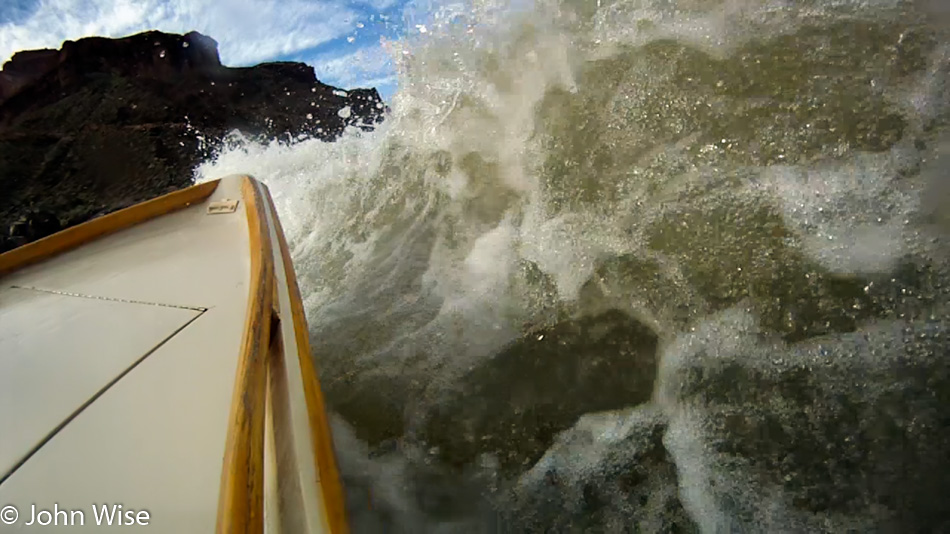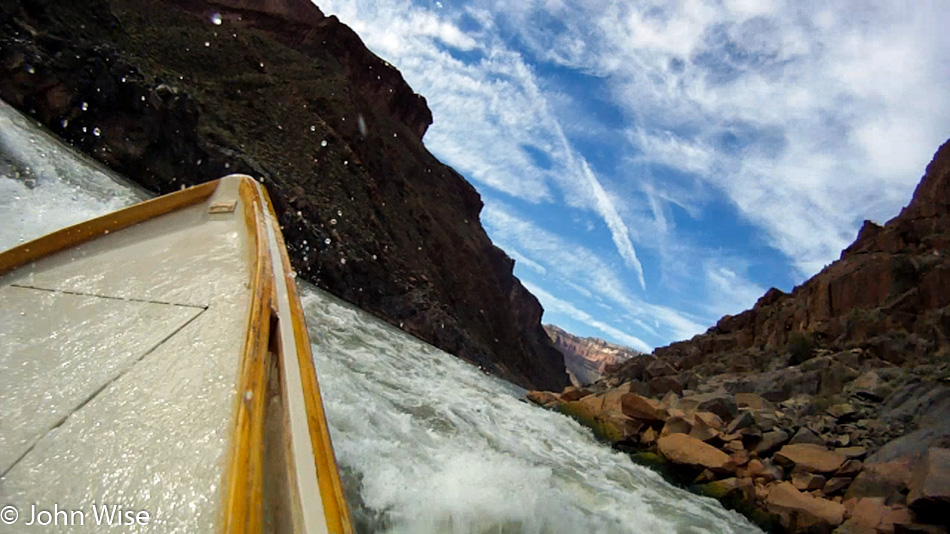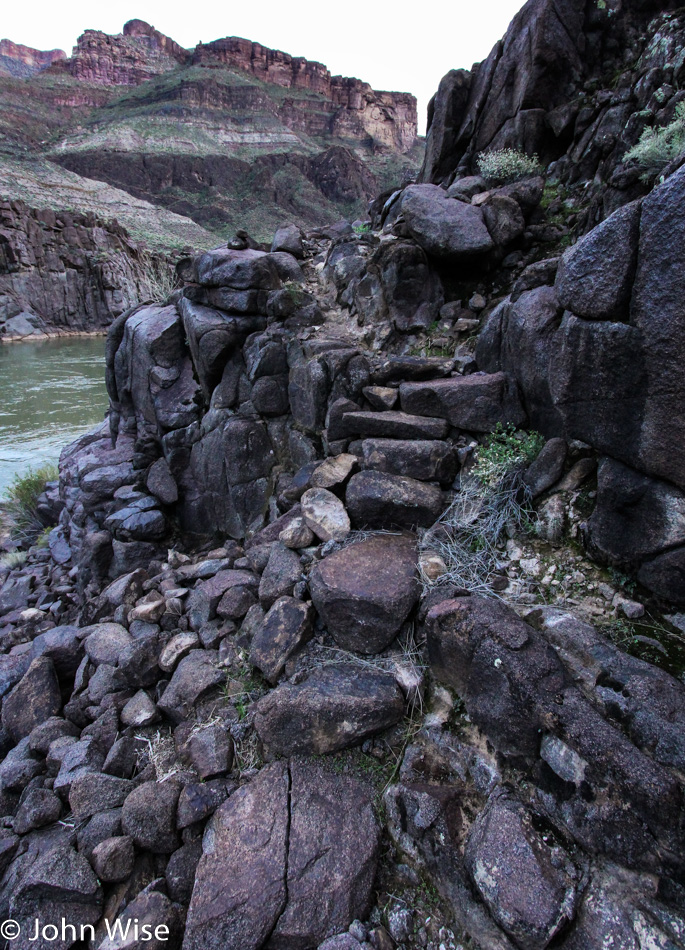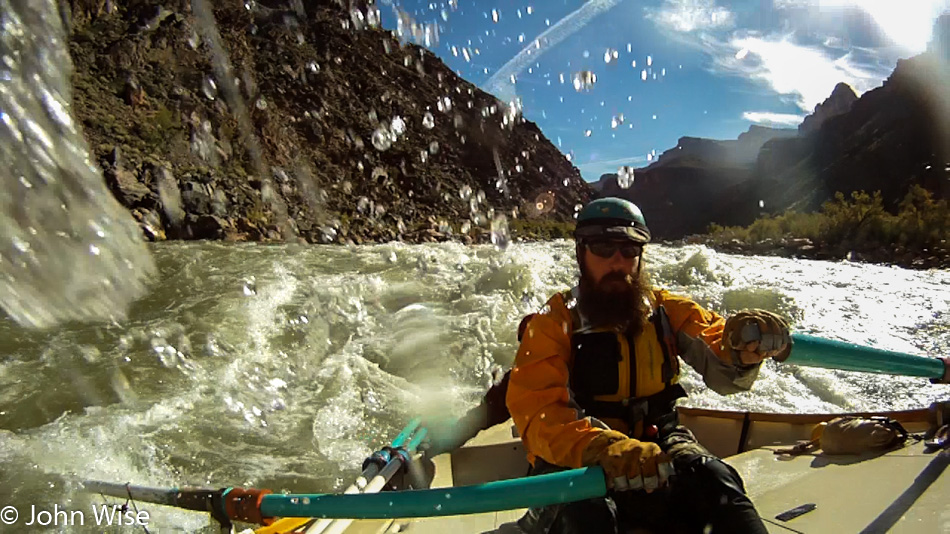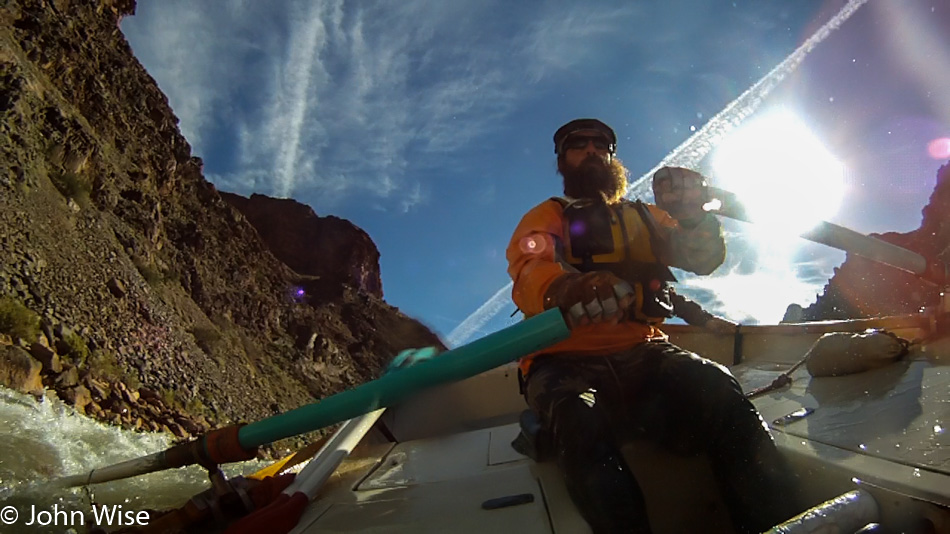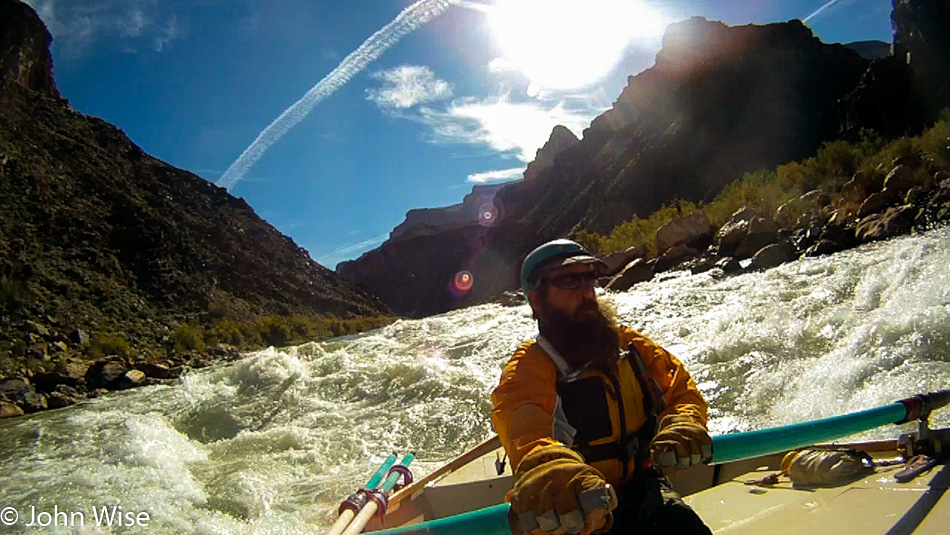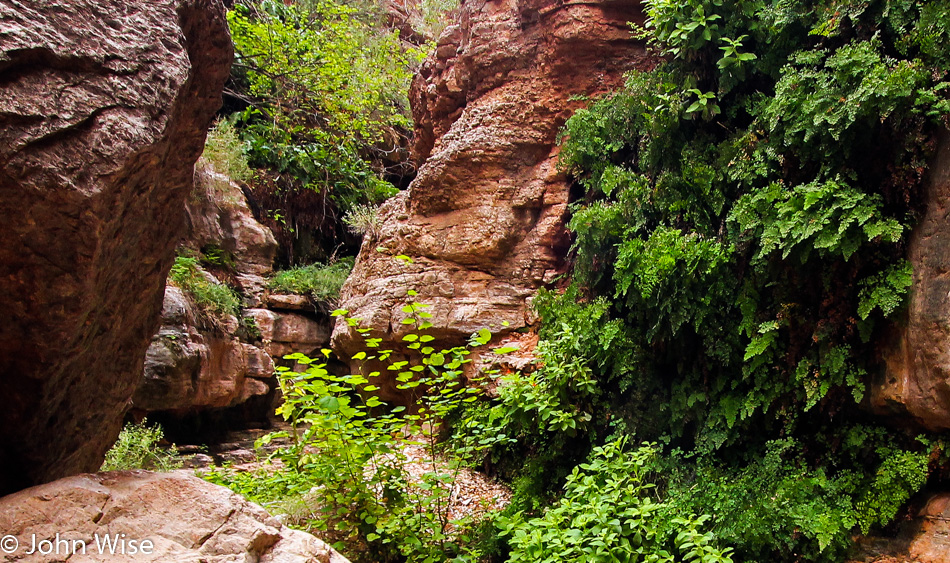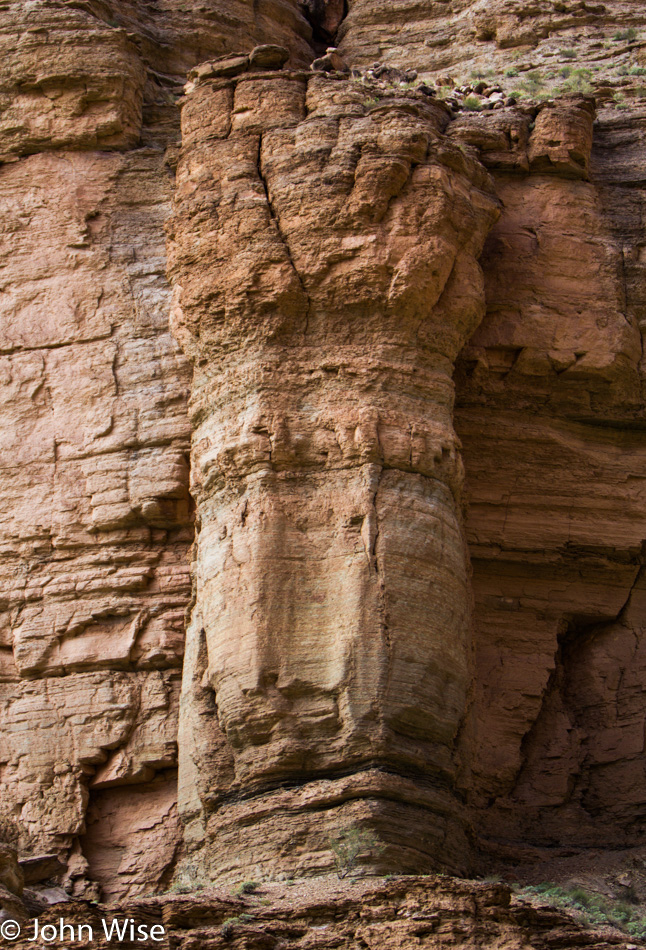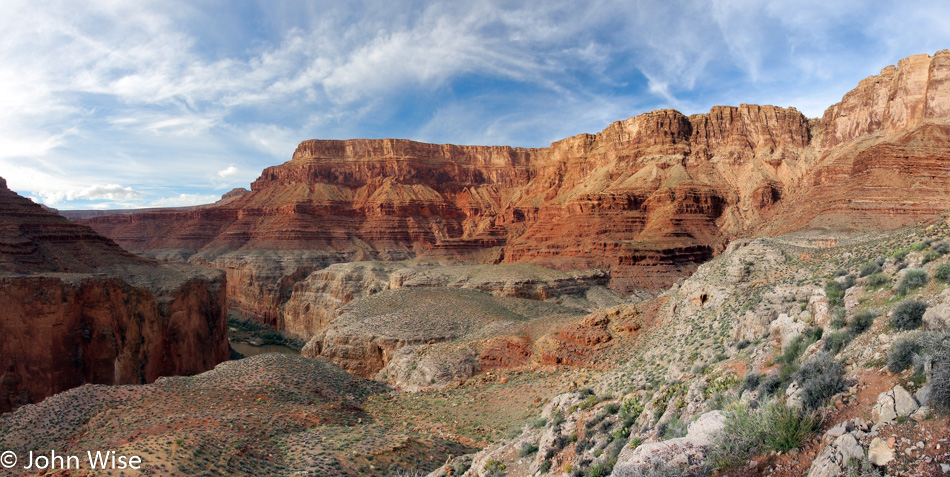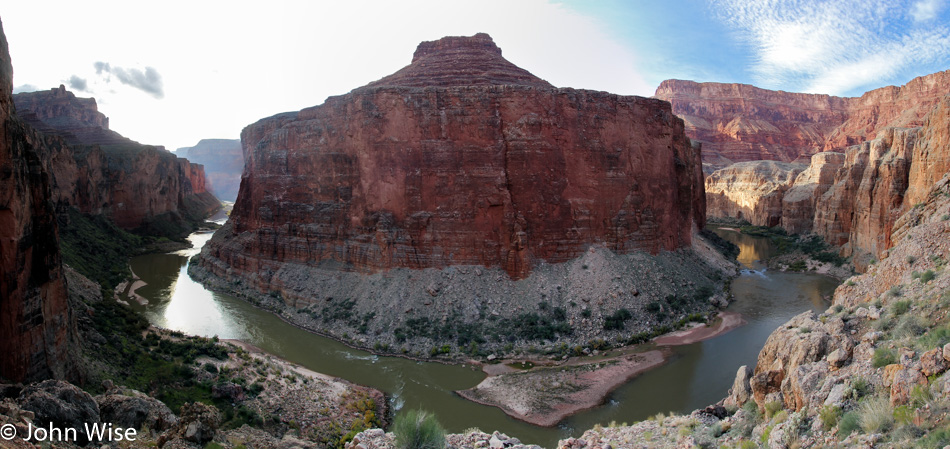
I wake up and head to the kitchen for a cup of coffee. On my return to the tent, I find one of the hikers we shared camp with last night sitting riverside on a large rock. After a demanding hike down the South Bass Trail yesterday, a group of four backpackers quietly set up tents off to the side of our camp and prepared their dinner. The affable guy basking in the early morning light offers a “Hello,” which I return with a wish for a good morning. I ask how their hike has been going, “Tough” is his reply. He asks about the dories, “Amazing,” I offer in return. He introduces himself as Bill Karren. With coffee in hand, we learn where each other comes from: I from Phoenix, Arizona, he from Las Vegas, Nevada. Bill and his nephew Robert are traveling with a friend and his wife. They are here for a long weekend. It appears they, too, have fallen prey to the Canyon. Bill offers up that he has spent quite some time in the Canyon, especially on the rim. This begs my curiosity as to what specifically has drawn him in. It turns out Bill was the lead engineer of the Skywalk out at Grand Canyon West on the Hualapai Reservation. The Skywalk is a massive, million-pound, horseshoe-shaped platform, extending 70 feet off a sheer ledge, standing 4,000 feet over the Colorado River with a view through its clear-glass floor to the Canyon bottom below.
I had made a commitment to myself prior to departing for the Canyon that talks of careers and previous adventures were not going to be part of my dialogue. I would stay in the moment of being in the Canyon without the outside world intruding upon my experience. And so I fight back my rising geeky curiosity and politely refrain from asking Bill for some details or trivia that would take him back to work and out of his own moment of watching the light of day climb into the Canyon with the sounds of Bass Rapid filling the air. I wish him a good day and continue on my way, reminded that we never know who we might meet along our path in life and to not be afraid of saying hello to the people we pass on our journeys.

Within the hour, we break camp and board the dories. It is river time again! In no time, we are leveling the puny Bass Rapid before striding past the mouth of Shinumo Creek and Shinumo Rapid. At 110 Mile Rapid, the river performance award of the day would go to Sarge, who crawled out on the bow of Bruce’s dory. With a roaring hoot and a holler and his feet kicking wildly, Sarge rode the front of Bruce’s dory like a rodeo champ atop an angry bull. His inspired ride arrested everybody’s attention, while his song of yelping delight allowed the rest of us to share in his thrills. Should you one day find yourself on a wild river, retired, in your 60s, with a boatman who invites one of the passengers to take a bow ride, picture and remember this former officer of the law sitting out front on the bow of the dory with feet dangling, bellowing a shriek of gut-busting fun, laughing out loud, full of wild abandon. Remember to get out there on center stage and live it up.
Here a rapid, there a rapid, and in between, I yearn to pull out my camera that is everything but waterproof. The dry bag holding my camera and an extra zoom lens is buried in the dory’s watertight hatch; as the danger of the rapids passes, I dare to pull it out. The timing of this is critical, as I don’t want to be caught fumbling with the repacking of the fragile gear and fail to get it stowed before entering the next stretch of whitewater. At times, we can hear the rapid around the next river bend before we can see it. Other rapids are not heard or seen, but the boatman knows it’s approaching, alerting me to stow the camera.
We pass Copper Canyon without incident, followed by Hakatai Canyon and its rapid, leaving just one more mile until we reach the often difficult run at Waltenburg Canyon. This is another rapid the boatmen will scout. Whether they will read it as being a giant, maybe a little unpredictable, having a big dangerous hole, holding the potential for a collision course with a wall of stone, or an all-of-the-above rapid, I don’t want to know. Do you ever get the feeling after seeing a movie trailer that you just witnessed the entire film, canceling the need to see the other 89 minutes? To me, it is more exciting to enter the rapids without the knowledge of what is about to crash into us. I do not want to hear the boatmen’s assessment or watch them point to the really dangerous sections as, once on the river, a part of my attention would then be diverted to watching the technical precision exercised by the boatmen and how they handle the river’s rage. Right now, I am here for the ride, wanting to walk into this experience clear of expectations other than the unvarnished curiosity to be in the here and now. And this blockbuster titled Waltenburg Rapid? It played well with a strong opening wave; my attention was held through the frothing middle section before rowing into calm waters to deliver a great ending. As the credits roll, we applaud the director at the helm of our dory; the lighting guy in the sky was on it, and the effects supervisor produced whitewater thrills worthy of an Oscar. Special thanks to the producers of this great action adventure over at Grand Canyon Dories and the O.A.R.S. Company – bravo.

Four miles of calm water follow. This is one of the longest stretches of slow-going river in days. On these quiet, still waters, the Canyon is revealed while we drift like a cloud, silently skimming the earth on a slow boat into the mysteries. There is nowhere to rush to, nothing requiring us to brace against a cold splash of an approaching rapid. We do not know our destination, sticking with the theme of remaining indecisive to have the greatest flexibility. Secure in the knowledge that we will stop at what looks promising to the boatmen, we sit back and crane our necks to give our senses the best shot at finding all of the color, texture, sound, and detail that can be had in this place, where so much can be experienced in the blink of an eye.
On river left, I spot an astounding sight: the dry drainage channel of a cascade. It is easily apparent from the smooth-sloping Vishnu Schist that a powerful and abrasive torrent of rushing water has been occurring here during the rainy seasons. Not only is this metamorphic rock being polished to a finish as smooth as marble, but there is also an orchestra section of flutes sitting at the foot of this periodic waterfall. How I wish to return on one of those rare days when the flow of nature’s stormy rhythm is at full volume.
How could I truly share or quantify the expansive magnificence of a landscape my mind is trying to interpret? How does one build a visual narrative when our words manacle allusions of beauty to an impoverished language that struggles to convey what the eyes and mind are able to perceive? The only conceivable solution is for others to put themselves in the time and place where perfection will be witnessed but not contained, not imprisoned, and, ultimately, will not be truly shareable. We must get out of our own way and, on occasion, find ourselves in the unfamiliar.

Is the boat slowing, the river taking a pause, or is time being pulled into the slow gravitational heft exerted by the Grand Canyon’s weight of beauty? From rim to talus slope, from the edge of the silty river to the crisp blue sky punctuated with white tufts of cloud, the gradations of earth’s rainbow radiate flowing layers of color and sound directly to the sense organs that give us humans the ability to be awed in fascination. I stand transfixed, unable to break my hypnotic gaze after the logical mind takes an exit. The daydream of the child is reawakened. I am without the need for thought or critical analysis as I find and bask in this escape from a harried life that requires me to be nowhere and everywhere at once.

Let this be my heaven, my nirvana, my eternal resting place. To forever find myself floating, content, caressed by a beauty embracing my physical and spiritual being. Grant me my wishes and perceptions as I try to remember what perfection could look like. If this isn’t my last stop in life, then let time stand still another moment, offering this faint sound of water flowing, the breeze whispering, a bird’s wing flapping, and the warmth of Caroline’s hand holding mine. Time to exit the boats.

One short scramble for humankind, another new world for my imagination. A quick hike brings us to a living room-sized canyon stuffed into a small corner, tucked away out of sight, a universe away from modern reality. Elves Chasm, a wishing well and pool of eternal solitude where nature, without the help of man, brought a dalliance of beauty into being with its exquisite waterfall, mysterious dark corners, flowing green mosses, and ferns. For thousands of years prior to man’s recent arrival, it was appreciated by birds, lizards, butterflies, and spiders. By the time Elves Chasm was finished preening itself to this current state of preeminence, man would stumble into its chamber to be given a lesson in the definition of tremendous. Standing here, as one of the twenty-two visitors and possibly the only group that will stop today, it is glaringly obvious I must have won the lottery of golden opportunity. Consider that every sixty days, a million people, on average, visit the rims of the Grand Canyon, almost a mile above, while less than 15,000 people a year will ever have the chance to stand here.

I try to understand this conglomeration of beauty accumulating with each successive impression of delight, stirring my sense of the aesthetic. It is as though I have become entangled in the DNA of the Grand Canyon, which is drawing me in to share its hidden secrets, wrapping me in its code of sensual awareness. Finding myself in this spiritual accretion, I let it take hold of me, shuddering under its enormous mass, which acts as an amplifier of who I am. I come in with love and feel it grow, magnified by the immensity of the place I stand before. Entering with an awareness of the excitement brought by adventure, the exponential growth of that desire propels me into a life where adventure rules – see boatmen for confirmation of this maxim. This echo chamber resonates with my thoughts and dreams. My tears join others’ tears to run down the chasm walls. My joys fall over slopes and across boulders until the emotional wave of intensity pulls me into the depths of the river called Self. My lungs fill to bursting capacity, forcing out a gasp of astonishment that all of this is happening to me.

Andrea goes first, diving under the surface at the foot of the waterfall to check its depths, declaring it safe for anyone interested in leaping from the slippery ledge halfway up the slot wall. She swims over to a dark recess to the right of the waterfall and climbs up behind the wedged-in boulders, emerging on a shelf above. Once situated on the lower boulder, she leaps off to plunge right back into the chilly waters. Caroline watches a few others make the jump before wrestling with her uncertainty to determine if this is something she has the nerve for. She finds her courage and swims through the pool, crawls up under the boulder, and in a moment, my wife stands on the precipice and leaps; popping out of the water below, she is all smiles.

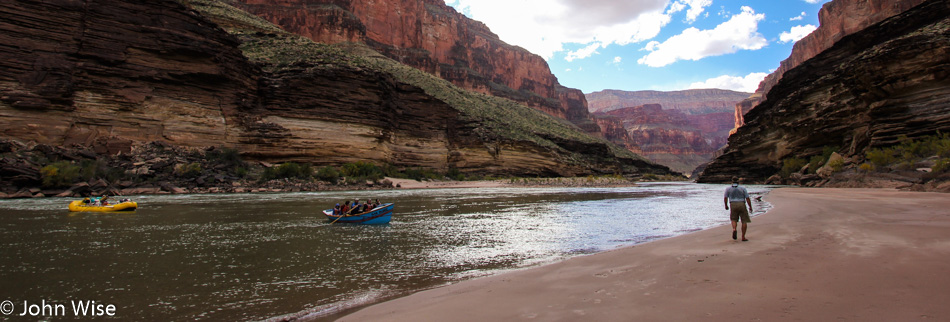
Having seen all that we can see at Elves Chasm during our short visit, we depart on the short 10-minute hike back to the dories. The next stop comes but a few miles downstream. After landing on a wide beach, Rondo demands our attention and offers guidance regarding our next actions. He asks that we show consideration and be respectful of this special location. Here, Native Americans walk in veneration. Under the watchful eye of nature, we are about to pay homage to the spirit of the Canyon.

In quick procession, we begin our hike into Blacktail Canyon without a word being spoken, not a whisper exchanged. The path leads over a short hill, delivering us to a drainage and our first glimpse up this side canyon. The trail narrows rapidly before disappearing around a bend further ahead. Gravel gives way to larger river rocks, demanding we watch our footing as we follow the person in front of us. We are moving away from the sounds of the Colorado, walking into where the silence grows. Sunlight becomes scarce, finding it gradually more difficult to shine its way beyond the closing gap above this slot canyon.

Up ahead, Bruce stops and waits for the group to gather around. We are standing on the Great Unconformity, which, for my sake, should have been called the Great Mysterious Mind-Boggling Unconformity of Astonishment. There, right before my face and within my grasp, I reach out to touch the transition from Vishnu Schist to Tapeats Sandstone. My hand straddles that vast period of missing time, bridging the gap between unicellular life and the beginning of the era of multicellular life that would give rise to fish, plants, birds, bees, dinosaurs, and now us.
From here, still, not far from the Colorado, we continue on our way deeper into the side canyon. The dark walls stand next to us like parentheses, bracketing our trail carved by the numerous flash floods that cut these curves into the layer of Vishnu Schist. Ribs of white quartz thrust upwards through this hard metamorphic rock, giving the appearance that we are walking inside a whale.

A bit further, the narrow path opens into a chamber, my eyes drawn to the majestic elegance of the sculpted walls rising like pillars to the sky. We have entered Earth’s cathedral. Reverence takes hold of our pace, slowly pulling us into the realm of the spirits that inhabit this hall of the eternal. Without exaggeration, a pin drop would be out of place. I have never before been witness to a group this size moving with such quiet as to not let a single sound escape. It looks as though everyone walks alone, the cluster of bodies having pulled in separate directions, giving each individual the space to share a part of the essence one and all must surely be feeling. Heads tilt upward before the eyes trace contours back down to the canyon floor and the small stream that flows over it. The concentrated silence adds to the sense of the holy by anointing us with mute appreciation that such a place still exists in our busy world.


Partway into the Canyon, Katrina, and Jeffe, with guitars and mandolin by their sides, take up seats on a couple of large boulders. They are waiting for us to finish our exploration and return to this passage for a short concert. Most everyone stopped here, or so was my impression since after passing them, there were only a few people ahead of me. Whether the others continued to the end and turned around, I don’t know; I am too preoccupied with my own overwhelmed senses climbing back into the history of the Earth, being drawn in further and deeper. The cragged contours above us appear oddly symmetrical. Turning the corner, a final short walk will bring me to the end of the trail, but not the end of the story.
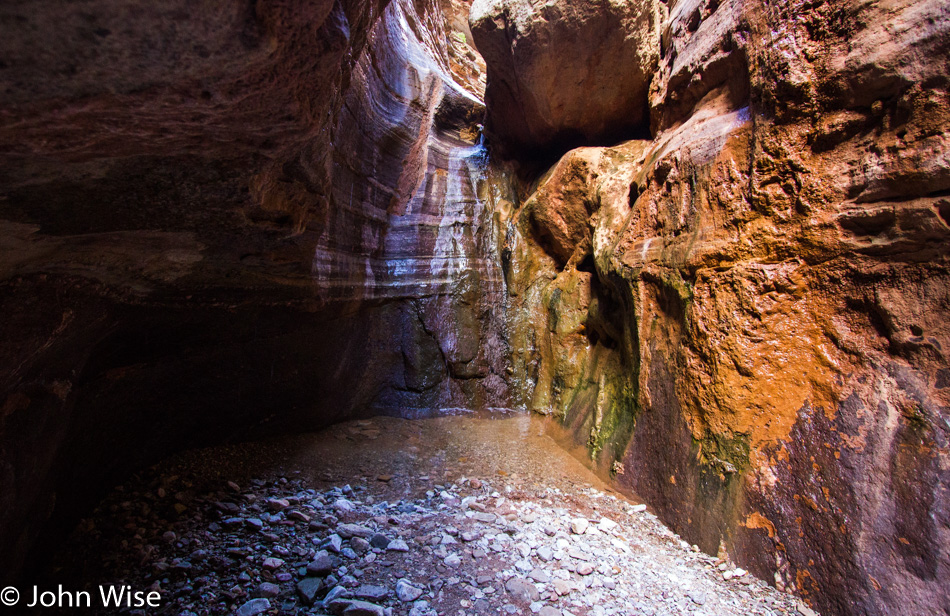
Here within Blacktail Canyon, far away from our distant sun, deep in the geology of our planet, I walk up to the edge of a small pool. A few feet above my head, a wisp of a waterfall glides through a channel carved into the Tapeats Sandstone to trickle down the rock face and onto the multi-hued Vishnu Schist. I reach out to touch the flow; it is warm. Like the water falling before us, I fall into awe as the feeling rises in me that I am standing before the single most beautiful place I have ever been. Emotions start to swell. I’m struck by the idea that I am in the presence of the very act of creation. Is this a picture of life’s beginnings: water, shade, minerals, warmth, oxygen, and time? In my imagination, that anonymous place where life began its evolutionary trajectory could have looked something like this.
On my right, a small seep gently percolates a carbonate solution, as evidenced by the travertine growing on the wall below. On the left, a drip from high above strikes a ledge, splashing tiny water drops upon my face. If I were below the Earth’s surface in a cave, I would feel that the droplets I had received were good luck kisses. Tears are streaming down my cheeks, bringing the salt of Earth back to the waters that are essential to this circle of life. In front of and above me are the deposits of sand and earth, fossil and rock, representing hundreds of millions of years of evolution that have preceded my own brief time. I attempt to grasp the idea that within each inch of rock, a history of life’s progress can be found.
I search for myself in this soup of biological and geologic history, feeling the spirit of life abounding, exploding within me, one hundred trillion cells, an amalgamation of water, flesh, heat, minerals, bacteria, gases, and a handful of ephemeral, intangible thoughts, imagination, and dreams, struggling to find comprehension. My poor brain is overcome by emotion, nudging me towards weeping – the tears don’t stop. This sense of life has never resonated so strongly within me. My encounter with Blacktail Canyon has opened the floodgates to finding the spirit of life that embodies all that is around and within. I am reminded of the Navajo prayer paraphrased here as, “Beauty before me, beauty below me, beauty all around me, I walk in beauty.” Today, I am alive in that beauty.

I could have stood there forever – maybe I still am. Maybe a part of me will never leave. Did my falling tears evaporate and ascend to the clouds, or did they join the stream to flow into the Colorado and points beyond? Maybe they are on their way to help grow food, or maybe they will add to the drink of another human, plant, or animal, helping sustain life outside this isolated Canyon. Ultimately, my tears and the rest of me will rejoin this earth that has borne me. Knowing that I am returning to my origin in this cycle of life gives dimension to my presence and a better sense of perspective regarding the brevity of my existence laid bare right before my eyes today.
On that last day, when I lay down my life, I hope to know what my contribution has been. I would like to believe that I helped improve the blueprint that brings smiles to our faces, warmth to our hearts and that swirling, giddy sense that we are seeing the beauty in all that is around us, in each and every one of our hearts and dreams. I now see our happiness and fulfillment as more like these fossil layers, slices of experience that are lending themselves to the structure of what I loosely understand as life. You, me, us, them, it, this thing, that object, we all are built in this stack of life, one upon the other like so much sandstone.
Take the time now, do it when you are young, teach your children, and find it when you are older, but don’t ignore the magic of being alive, don’t pass by the opportunities to learn that beauty is not only what the eyes deliver, but, more than that, beauty is what you find within yourself. Is it the flower that inspires that intrinsic value of delight, or is it the very moment in your mind when you have given into accepting that it is, in fact, beautiful? How is an individual flower petal more or less beautiful than any one of the faces you looked upon today? Why are the mountains more attractive than the individual grains of sand that erode from them? What if all the beauty imaginable were to be found in sand? What ecstasy might you hold with a single handful picked up from the beach?
Beauty is there, you once knew it, and our youngest children can still find it. In the grass on a dewy morning, get down on all fours, then lay down. Bring your face close and focus an eye on a lone blade of grass, one that has some dew clinging fast. Now, look into a single drop at the refraction of the surrounding grass blades and sky you are seeing in that tiny orb. It is only water and grass when seen from afar, where you have no need to describe the unseen as beautiful or ugly, but when time and perspective slow down the rush to opinion, we just might see beauty in the mundane. Reconsider how quick we are to give a brand of aesthetic quality to many of the things and people we meet and see. Try to understand that our fossilized remains in a future sandstone layer will not be seen or appreciated for how rich we were or how we appeared to others. We should hope our contribution to life will be known from the qualities and values we embrace and, if we are lucky, by how we improve the planet we live on. We must learn new ways to celebrate this life and help one another find the moments to visit our own personal version of Blacktail Canyon to look deep into who we are.
Next, explore the meaning and value of time. While we are still able to see, walk, talk, read, write, learn, play, and think – recognize that our time is short. Not depressingly short, but certainly soberingly brief. The math is simple. How long do you think you might have on this Earth as a sentient being? 75, 80, 90 years? I’ll cross my fingers and opt for a good, productive 80 years. Multiply the number you come up with by 365, the number of days in a year. My calculation, using 80 years, gives me a total of 29,200 days of life. Don’t panic, but don’t do nothing, either. As I write this, I have already spent 17,425 days of my allotment, leaving approximately 11,775 opportunities to do and see all that life has to offer.
Now, let’s put this into some perspective. If each day of my life is represented by a single cent, I will start with $292 worth of coins or 584 rolls of pennies. How old am I today? Multiply that number by 365 and remove the result from the pennies in the main stack. I have about $117 left. Now, I try to recollect the most meaningful days of my life so far and put a penny to the side for each of those memorable days. How much did I move to this pile?
With this in mind, are your days and potential for experiences only worth a penny you would be willing to toss to the side? Or are they worth a nickel, a dollar, or maybe, like mine here in the Grand Canyon, are they each worth a small fortune? Every day a penny is spent, will you have bought another day in front of the television, more time texting, another night forgotten in drunken loneliness? Or will you explore the map of the unknown, not-yet-experienced opportunity within you? Take inventory of your pennies and account for them well: this savings account does not pay interest. Cherish your days, invest your time wisely with family, friends, fun, travels, new hobbies, learning, sharing a meal, and a smile; it is from these things we enrich our lives. After all, $292 isn’t exactly rich.
Today, we have reached the halfway point of our trek through the Canyon. We are passing the equidistant mile marker figuratively placed between Lees Ferry and Diamond Creek. It will be here, in Blacktail Canyon, that I stumble into the deepest depths of myself and where I will have to start the process of crawling out of me. I have stood here before the waterfall for an indeterminable amount of time, waiting for the intensity of my emotional reach to fade and allow my eyes to dry. Caroline approaches, placing her hand on my shoulder; I wrap my arms around her. I try to suppress the tears but feel that her touch has reopened the dam. I am certain she must feel the buried convulsions shuddering through me as this uncontrollable need to weep takes over my ability to hide behind the requisite image of manhood that has been instilled in me.
While Caroline consoles me, I see that fellow traveler Steve is in prayer; his head bowed; he, too, is finding reverence in nature’s shrine. Another passenger, Joe Kutter, is also here with us under the waterfall. As though right on cue, he finds an open window in our shared moment, and with all the grace and benevolence befitting this quiet man, he sings “This Is My Song,” which is also called “Finlandia.” The lyrics are:
This is my song, oh God of all the nations,
A song of peace for lands afar and mine.
This is my home, the country where my heart is;
Here are my hopes, my dreams, my sacred shrine.
But other hearts in other lands are beating,
With hopes and dreams as true and high as mine.
My country’s skies are bluer than the ocean,
And sunlight beams on cloverleaf and pine.
But other lands have sunlight too and clover,
And skies are everywhere as blue as mine.
Oh hear my song, oh God of all the nations,
A song of peace for their land and for mine.
May truth and freedom come to every nation;
May peace abound where strife has raged so long;
That each may seek to love and build together,
A world united, righting every wrong;
A world united in its love for freedom,
Proclaiming peace together in one song.
After a short pause, he offers a prayer in song with a recital in Latin of Agnus Dei – “Behold the Lamb of God,” who takes away the sin of the world.
Caroline, too, is now in tears. Try as I might, I find it nearly impossible to turn down the wellspring of emotion, but eventually, I find my composure. With eyes drying, I use this opportunity to pull my hat over my brow before turning to start the hike out. The first person I passed was our trip leader, Rondo, who said something to me that I failed to note and later could not find in my memory, though the exact words are not as important as the sense of his gesture that will stay with me. His demeanor is reserved; his eyes seem to keep their distance, allowing me passage without disturbing where and what I am coming from. There is an implicit acknowledgment in his nod that he understands where I have been and what I am carrying with me. Simply writing these words now, so many weeks later, brings me back to those moments – my eyes start to pool, filling yet again with the waters of Blacktail Canyon.

On my return approach to the bigger passage, I begin to hear the quiet song Jeffe and Katrina are performing. I hope to pass through discreetly, not wanting to disturb the mood. The other passengers remain in personal silence, each taking in whatever it is that is speaking to them. No one looks my way; maybe they sense the weight of my stride and the fragility of emotions as I cut the widest path possible to avoid a hello that could wring yet more water from these tear ducts that have worked harder today than in many a year. Fading behind me is the sound of the instruments, with Katrina’s voice growing distant as she sings “Pony” by Kasey Chambers. Ten days ago, this ballad was unknown to me; today, I have a fondness for the song that has become part of my Grand Canyon soundtrack.
The sound of the river becomes audible again as we approach the mouth of this side canyon. With each step forward, the light is getting brighter, I am moving out of the shadows. The sun, which is now low on the horizon, shines onto the north-facing cliffs; it will only maintain its warming vigil for a few more minutes. Clouds, small and fluffy, are painted on the deep blue ceiling of the sky overhead; they don’t move, but my tears do once again. In these moments of leaving Blacktail Canyon, the story of the evolutionary creation of life completes its cycle; from the dark, damp shadows, life emerges out of the safety of its hidden corner to find the light of day, seeing for the first time the bigger world and the breadth of sky with its source of illumination – the sun. It is as though the primordial memory of life is encoded within me, that on this day, a playback mechanism was triggered, allowing me to witness the magic and joy, the mystery and ecstasy of when life had come into being, taking a step forward in its adaptation for survival, still unencumbered by thoughts and anticipation of what comes next, it was “in the moment.” It is here and now that everything feels new, beautiful, and full of love. It is here, in these moments, where I would wish to stay forever in the magic of time unspoiled by my mind, with only my heart and eyes acting as the guides to my being.
Now that I have left the trail, it is time to rejoin my fellow travelers. Before I can do this, I must first try leaving the depths of myself still exploring Blacktail Canyon, trying to make sense of this experience. As I have come to understand this, in some small way, the weight, the hardness of stone, the narrowness of the passage, and the towering walls encapsulating me all worked in concert as nature’s reflection of what was already deep within me, and likely carried by each one of us human beings: Our time of innocence, when love and warmth still radiated all around us.
As adults, we have become jaded by our fears, our familiarity, our mistrust of the world, and our cynicism as we struggle to survive in a cold, violent world that is of our own making. How many of us are guilty of mindlessly allowing our children to witness the cruelty that will make them pull inwards, become mistrustful, and share our own cynical view that one is effectively alone in this life? We are perpetuating our own misery and passing on an imprint where love is but a small part of a busy day. Today, I had to cry. I wept. The tears washed away the blinders that had isolated me from feeling love all the time.
It may, in part, be due to our own laziness that, with our tacit agreement, we encourage our media to inundate us with a barrage of small-mindedness, war, and violence. If we are to truly enjoy life, how will this be accomplished by filtering our daily experiences through the unhealthy fetish of voyeuristic pandering to the sense of the absurd, bizarre, and violent depravity demonstrated by a species that is supposed to be capable of so much more? Maybe it is time to turn off the violence of crime dramas and the news, time to change the radio station from hate-talk camouflaging itself as the voice of the truth. Stop our own dialogue about how bad our job or day is, stop the gossip about the terrible neighbors or coworkers, and halt the insinuation that many around us are nearly incompetent or simply too different to tolerate. Instead, explore everything that celebrates this incredible opportunity of finding ourselves alive and able to create, beautify, share, listen, and learn of our planet and one another. It is certain that we must know and be aware of mankind’s dark side to help us see where to lift ourselves and our fellow human beings out of the abyss of monsters, but it is also important that during our time on Earth, we should find the path to stroll in the forest of artists, thinkers, teachers, mentors, shepherds, storytellers, and the insights of the wise. We must reset our compass and get back on track to continue our ride into the setting sun, where not a sign of a corrupt civilization is found on the horizon, where we are all explorers of the frontier found inside of us, treasure hunters looking for the wealth buried within, hidden underneath thick skin and callous minds.

Back riverside, Kenney’s dory has taken flight while left on its own. Fortunately for us, the Colorado hasn’t taken it very far, and it is found nearby swirling in an eddy. Kenney corrals it, and soon, we are again traveling the Colorado River. As will be the late-day theme for most of the remaining days of our trip, we are rowing into the sunset: after traveling south for the first seventy-five miles, we are now heading west.
The dory is our pram, the Grand Canyon our home, the river the sidewalk leading us to our friends and neighbors. Boatmen teach us how to be safe and are nearby to tend to our injuries. They make all of our meals, ensure we have enough to eat, and remove our waste. We are brought into new experiences. These guides are our teachers, imparting a new vocabulary into our speech; we become familiar with gunwales, dories, oarlocks, trim, first light, and intrusive dikes. We learn of boat construction, geology, river hydraulics, the anthropological record of those who were the ancestral stewards of the place we are visiting, and most importantly, we learn about ourselves as we grow up just a little bit more each day.
During our early childhood, everything was new and nearly incomprehensible. Our time here on the river follows a similar path – it is too monumental and bewildering for us to retain all that we have seen, thought, and experienced. The lore shared with us these days and nights regarding others’ experiences in the Canyon, and specifically, the stories of Blacktail Canyon told tonight by Rondo and Kenney, are lost in the immensity of information. There is no rewind or repeat button for this performance. I am finding a new appreciation for the stories told by our guides, and wish them to be told over and again. It is indeed sad that we belittle or diminish the enthusiasm of our friends, family, and the elderly who want to tell us their stories over and again, for if they should only be told once, they would be quickly lost and forgotten. Isn’t this need to tell and re-tell our stories and those of others a fundamental element of our humanity? This need could be an instinct protecting our survival, giving purpose to the spoken word that is at the center of being human. For if we were only in need of voicing our immediate desires, I’m certain that crying, a bark, a meow, or some other primal sound would suffice in carrying us through meeting our needs. Fortunately for us, we have this voice, this written word, poetry, music, and the ability to create pictures that allow us to share, to find excitement in our experiences, to bring others into the vision of how we are affected by our world, love, nature, and each other’s story.
We are rowing into the next frontier, following the sunset, looking for our place amongst the stars.
–From my book titled: Stay In The Magic – A Voyage Into The Beauty Of The Grand Canyon about our journey down the Colorado back in late 2010.



